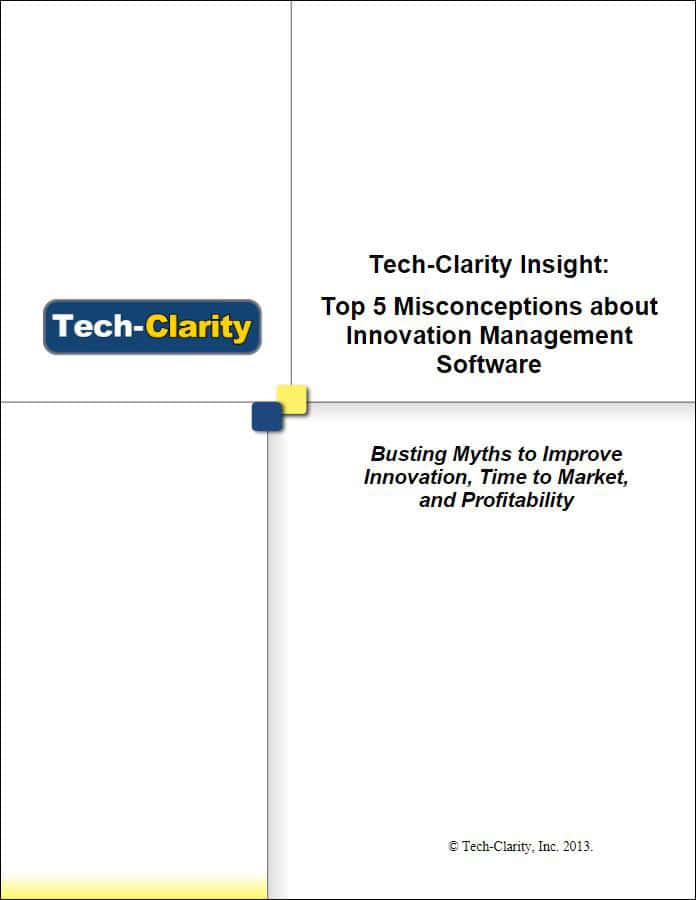
In today’s race to digital convergence, it’s becoming more imperative to engineer product innovation management into the development process. This is about more than coming up with good ideas. From a product development standpoint, Tech-Clarity defines “innovation” as “Developing, acquiring, or applying capabilities to meet market needs and developing those capabilities into new or greatly improved products to provide new customer value.”
Product organizations strive for this daily, yet studies show that about 75 percent of new products fail or fall short of their financial goals. Why does this keep happening? It’s everything from picking the wrong products to bad execution to missing market windows.
Research through the years has consistently found that the number one pain point of product organizations is too much work and not enough people to do it. Not only that, but product development folks often have limited visibility into incoming demand, so they cannot prioritize their people and work effectively.
Why is this the case? It all comes down to tools. Too many organizations are using the wrong tools—including spreadsheets—to manage an increasingly complex process.
As a result, companies are struggling to effectively:
- Grow revenue by picking winning products for a higher value portfolio
- Improve time-to-market by making their gated process more efficient
- Cut costs by increasing visibility for all stakeholders
The product organizations that are doing innovation right are automating everything—from initial idea to end of life—using software. In its paper titled “Top 5 Misconceptions about Innovation Management Software,” Tech-Clarity defines “innovation software” as “…the infrastructure that helps companies generate compelling ideas, nurture them, optimize their investments, manage projects, develop products, launch them commercially, and analyze their market performance.”
Here are a few examples of organizations that are using innovation management software to enhance the product delivery process and pick winning products, speed time to market, focus resources on the right projects, and deliver visibility to stakeholders.
Choosing the Right Products
Building Materials Company Accelerates Development of the Best Products
A fast-growing building materials company had a strategy to gain market share with new, innovative products. However, the company had a problem with resource management and new product development governance. Resources were being pulled in too many directions at once and innovation was stalling. Without visibility into where money was going, discerning margins and determining ROI was difficult.
“We had fantastic products but we were slower than we should be to develop our growing product portfolio, and costs were running too high,” said their innovation coordinator. “Much of that was due to our lack of visibility into reliable data and resource capacity.”
To address this issue, the company formed an innovation department to focus on product ideation and development. They implemented an innovation management solution, which quickly became a valuable diagnostic solution to identify risks, costs, conflicts, and resource issues. The solution supports the company’s new phase gate model and provides visibility for decision making and a feedback loop. All risks and issues are in the system and visible to senior management, who now monitor them closely.
“We can see things now that would have been buried, and this insight helped us cancel under-performing and high risk projects before they drained more resources,” continued the innovation coordinator. “… by cancelling doomed projects early, we can focus on ones that have less risk and bring more ROI for our organization. We could see that by leveraging skills from under-utilized resources in another facility, we could develop products faster and significantly reduce costs.”
“No longer do we throw money at a project without tracking it—our estimates are accurate, and our data is clean. We can identify and quantify risks early so we save money and speed development of only the best products.”
Improving Time to Market
Global Manufacturer Pumps Out New Product Launches
A worldwide manufacturer of pumps, valves, seals, automation, and services had trouble optimizing labor productivity and reducing time-to-market. Product ideas were being categorized incorrectly prior to the gated process, resulting in complex opportunities. The company had no global framework to benchmark progress, manage and track projects and resources, allocate funds, control costs, and measure success. Additionally, there was limited safeguards in place to enable flexibility when delays or changes in scope, resources, budgets, or competition occurred.
“Where a significant portion of revenues are derived from the sale of products, the rate and volume of new product introductions can have a significant effect on overall company growth,” said the company’s vice president of research and development. “Delays in product launch can have a significant impact on market share and thus, profitability.”
Using innovation management software, the company was able to:
- Minimize the unpredictability associated with product and technology development
- Manage the development and accelerate the launch of new products
- Automate the gate-review processes and improve time to delivery
- Enhance reporting and visibility to enable proactive decision making and course correction
In fact, the company had more product launches in the first four months of deploying the software than they did the entire prior year: “Product launches equate to increased revenue. We are accelerating the value R&D is delivering to the company…” continued the VP.
Bakery Supply Company Discovers the Secret Ingredient to Reduce Time to Market by 70 Percent
In another example, a global manufacturer of bakery ingredients, finished products, and services wanted to speed up its product development cycle to deliver innovative products faster. They lacked standardized tools and had numerous databases and manual spreadsheets, making it challenging to determine which projects had the highest probability of success and which required attention.
By implementing innovation management software, the company accelerated project execution and reduced average time-to-market by 70 percent. This was accomplished by, among other things, being able to:
- Provide reliable data for upper management to base its decisions
- Reduce the number of projects in the funnel using project score prioritization
- Implement automated phase-Gate processes to set goals linked to the timeline
- Establish clear accountabilities and responsibilities, cutting red tape, and empowering teams
Gaining Visibility into the Product Pipeline
Education Company Finds Enlightenment, Improves Product Delivery with the Right Data
The product development organization for a leading educational content, technology, and services company was managing its projects and resources with Google spreadsheets. These spreadsheets became large and unwieldy, consisting of 300 rows of projects and 67 columns of metadata. Roadmapping and long-term planning were disconnected from resources or other timelines, making it extremely difficult to accurately forecast capacity.
Using innovation software, the product organization integrated the planning and execution stages of product delivery and is doing planning, forecasting, status, and time tracking all in the same product. They can prioritize projects and push certain projects down the timeline as well as identify which groups are missing full-time equivalents (FTEs) and need new hires or contractors. In addition, they are now able to show executives, with data, what projects can and cannot be done based on capacity.
“It is a very powerful thing to be able to show the executives, in a data-driven way, all of the great projects we want to do but can’t because we lack the staffing,” said the director of portfolio planning.
CPG Company Improves Product Development Health, Saving Time and Money
In another example, a health consumer packaged goods (CPG) company also lacked visibility into the work and projects in its pipeline, making tracking projects inefficient. It too was relying on static, manual spreadsheets, to-do lists and email strings to manage projects. They also lacked governance and effective processes to determine how and when projects should be prioritized and delivered to the market.
After deploying innovation software, the company was able to align projects and balance its R&D portfolio for sustainable project and portfolio management and capacity planning. Instead of having 30 resource managers spend three months pulling together a project list, they now conduct a monthly review with fresh data that is actually tied to their project schedule—a process that takes only three people less than a day to complete.
In fact, they now track all product launches against standard metrics, which provide the company with the data needed to make continuous process improvements. The projects are aligned to corporate strategy so all decisions are based on real data, keeping the company focused and efficient.
Planview Product Innovation Solutions
Planview develops and delivers product innovation software for the enterprise. We partner with great customers to help them optimize their two most precious resources—their people and money. Using our solutions, organizations can execute on their product strategy and deliver the most innovative, profitable, and differentiated products to market on time and on budget.
Our software automates the entire product lifecycle—from concept to end-of-life. Customers can increase revenue, reduce time to market, and improve portfolio transparency by:
- Filling the pipeline with the right ideas;
- Picking the right products and projects;
- Doing products and projects right;
- Using the right resources; and
- Providing the right level of visibility.
For more information about Planview’s product innovation solutions, visit https://www.planview.com/pd-product-innovation-lifecycle-management/.







